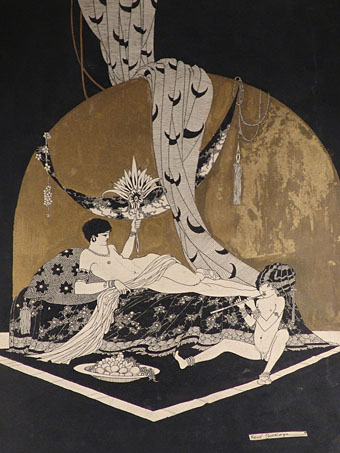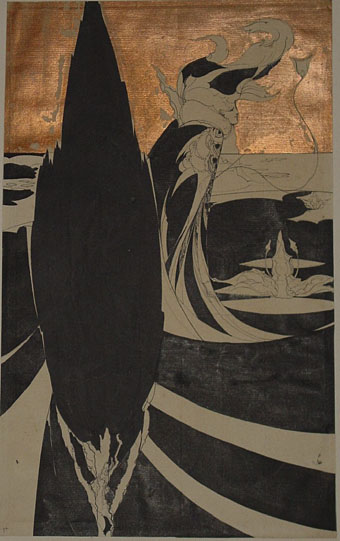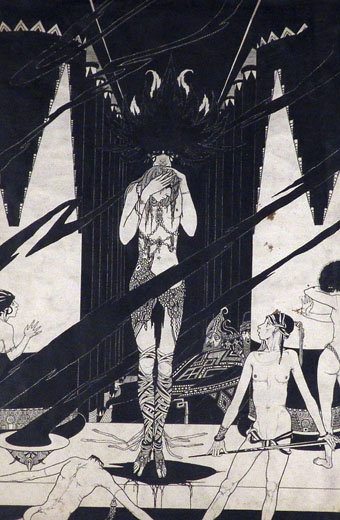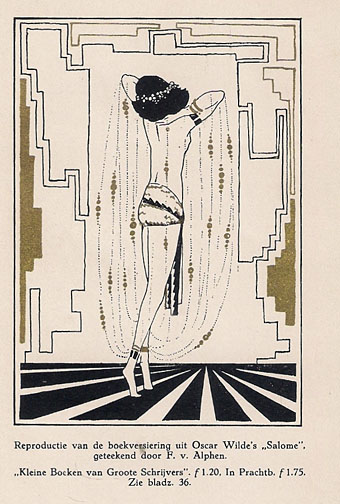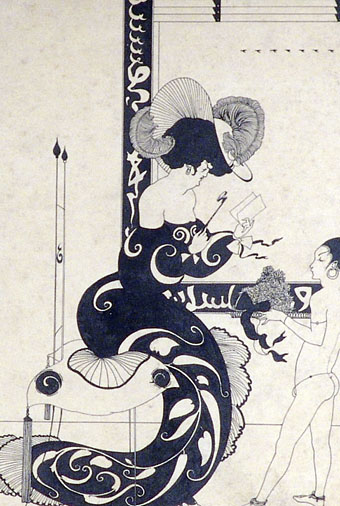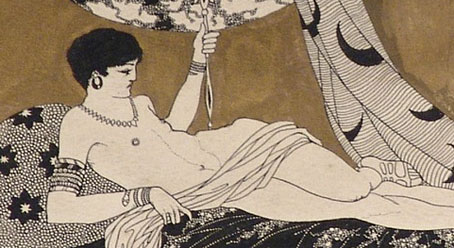
Presenting another guest post by Sander Bink concerning drawings by Dutch artists from the early decades of the 20th century, several of which show a distinct Beardsley influence. There’s also more than a little Harry Clarke in some of the details, especially the large Salomé picture below. Sander examines the provenance.
* * *
In our ongoing research into the influence of Aubrey Beardsley and Carel de Nerée in Dutch art of the early twentieth century, René Gockinga must be one of the most elusive. We wrote about him earlier but in the meantime we spoke to someone who has known him in the latter years of his life (he died 1962 in Amsterdam), she could not tell us more about the whereabouts of his early Beardsley-esque works. His more traditional Indonesian paintings from the 1930s sometime turn up at auction and I have also seen some samples of his post-WWII abstract paintings.
But of course, it’s the early, ‘decadent’ work, we’re most interested in. The RKD (Netherlands Institute of Art History) has pictures of about five of these, for the time being, lost drawings. So the Klein portrait was of course a great find. We were quite content and never dreamed of finding more unknown Gockinga’s (we do not know the whereabouts of the Salomé reproduced in the earlier post).
So one can image our surprise when we recently received an email from an art lover from Florida who had stumbled upon three drawings by Gockinga. At an Atlanta, Georgia antique show of all places! But then again: Gockinga has lived in New York from 1924 till 1932 or possibly 1938. At some point he might have sold his early work?
However it is, these are great and as far as we know never before seen examples of a quite talented but also quite obscure and neglected Dutch artist from the period. I suspect the main reason for this neglect could be due to the nature of his work which was probably too homo-erotic and pornographic for the (Dutch) public. As far as we know, he only had one exhibition where his Beardsley- and De Nerée influenced work was shown. That took place summer 1917 at the d’Audretsch gallery, The Hague. This gallery which owned a large collection of work by De Nerée and Gockinga must have seen his work there. Otherwise they could have seen his work someplace else at the early De Nerée exhibitions which took place 1910–1917.
In the first drawing presented here the De Nerée influence is apparent in the use of the golden painted background, a technique De Nerée applied in several works from around 1903, like La Promeneuse (below; collection Meentwijck).
We personally think that the Beardsley-esque curtain over the golden circle is a quite original touch. The scene itself might be inspired by the homo-erotic novel De berg van licht (The Mountain of Light, 1905–06) by Louis Couperus which concerns the most decadent of Roman emperors, Elagabalus. In 1914 Gockinga had already made two drawings inspired by the novel (private collection & Letterkundig Museum, The Hague) where Elagabalus is also seen reclining on sumptuous pillows. In the only known review of the 1917 Gockinga exhibition the use of colour is not mentioned, so this work could possibly stem from a little later, but probably not later than 1920 when Gockinga left for Indonesia and started working in a more Indonesian style.
The second drawing, judging by style and theme, must also be from 1915–1920. This is obviously a scene from Salomé. Curiously, it is not Salomé holding the head of John the Baptist but an Indian (?) looking male (androgynous?) figure. We see Salomé dancing in the right corner.
[JC comments: Or it could be Salomé looking more androgynous than usual; she’s supposed to be young but isn’t always depicted that way. The figure on the right may be one of the servants reacting in shock to the beheading.]
This Salomé figure curiously looks a lot like the one on a frontispiece by Frits van Alphen for a Dutch 1920 edition of Wilde’s play. (F. van Alphen. Prospectus for the 1920 edition of Salomé. Collection S. Bink) The drawing has a dark, violent charm which places it firmly within the decadent tradition.
The third drawing is most strongly influenced by Beardsley. See the peacock dress the lady is wearing and the two decorations on the left which are directly borrowed from Beardsley’s design for Downson’s Poems. The lady’s pose, the wig and the eunuch are also directly borrowed from Beardsley. It is tempting to think that this is one of the works of which the 1917 review wrote that the influence of Beardsley dominates over Gockinga’s own talent. It is rather a nice and technically skilled drawing though.
Although, to quote JC, “the Decadent ship had already set sail across an absinthe-tinted sea” by the time Gockinga put his pen to paper, these drawings remain curious species of fine decadent art by an unjustly forgotten artist.
Thanks to the current owner for allowing us to write about these works.
Previously on { feuilleton }
• Gockinga’s Bacchanal and an unknown portrait of Fritz Klein
• More from the Decadent Dutch

